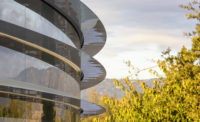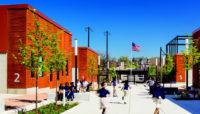Scarcely two decades ago, Sherman Creek, a tributary of the Harlem River in northern Manhattan, was choked by weeds and the wreckage of century-old boathouses. Now, the New York Restoration Project (NYRP) and Brooklyn-based firm Bade Stageberg Cox are on track to restore the area to the vibrant community hub it once was. On February 6, NYRP announced that with the aid of a $4.4 million grant from the Thompson Family Foundation, Bade Stageberg Cox will transform a strip of flood-prone parkland into a versatile education center and boathouse for the Washington Heights and Inwood communities.
“When you actually have buildings in a park, it invites a different level of interaction from the community,” says principal Martin Cox. “There aren’t many buildings like this along the river that are truly open to the public, that are interactive.”
In July, NYRP, actress Bette Midler’s nonprofit organization dedicated to greening New York City, was concerned by the lack of access and awareness residents had to the river. The organization, with the help of Dovetail Design Strategists, invited eight New York firms—including Desai/Chia Architecture, Urban Data + Design, and WORKac—to participate in the EDGE/ucation Pavilion Design Competition to come up with a resilient scheme for the park. Bade Stageberg Cox, which designed a two-building plan, was announced as the winner in December.
The firm’s winning design, Edge Portals, places two rectangular buildings on two separate peninsulas flush with the water’s edge. Since the site lies in a 100-year flood zone—an area that has a one percent chance of occurring each year—the building had to withstand water levels at 7.25 feet. “The issue of building to the waterfront is how to make a building that will flood, and flood repeatedly.” says principal Timothy Bade. “We used flooding as a way to design.”
Both structures will be made of a latticed, weathering steel skin, allowing for durability and permeability for floodwaters. The boathouse, a 3,500-square-foot rectangular volume, can house up to 24, 60-foot-long rowboats. Two gangways from the buildings connect with a floating dock, creating a protected cove in-between where children can conduct ecological experiments, including seining and oyster gardening. The firm wanted the educational building to be low-maintenance and serve as a tool in itself, so they integrated fieldwork instruments into the structure—including a skylight that doubles as a rain gauge and benches that show flood levels and soil horizons.
NYRP has already started site preparation. “We hope our project will be part of a green necklace with a string of water access along the way,” says principal Jane Stageberg. “It’s going to be a very unique place in the city in terms of its design and its programming.”










Post a comment to this article
Report Abusive Comment